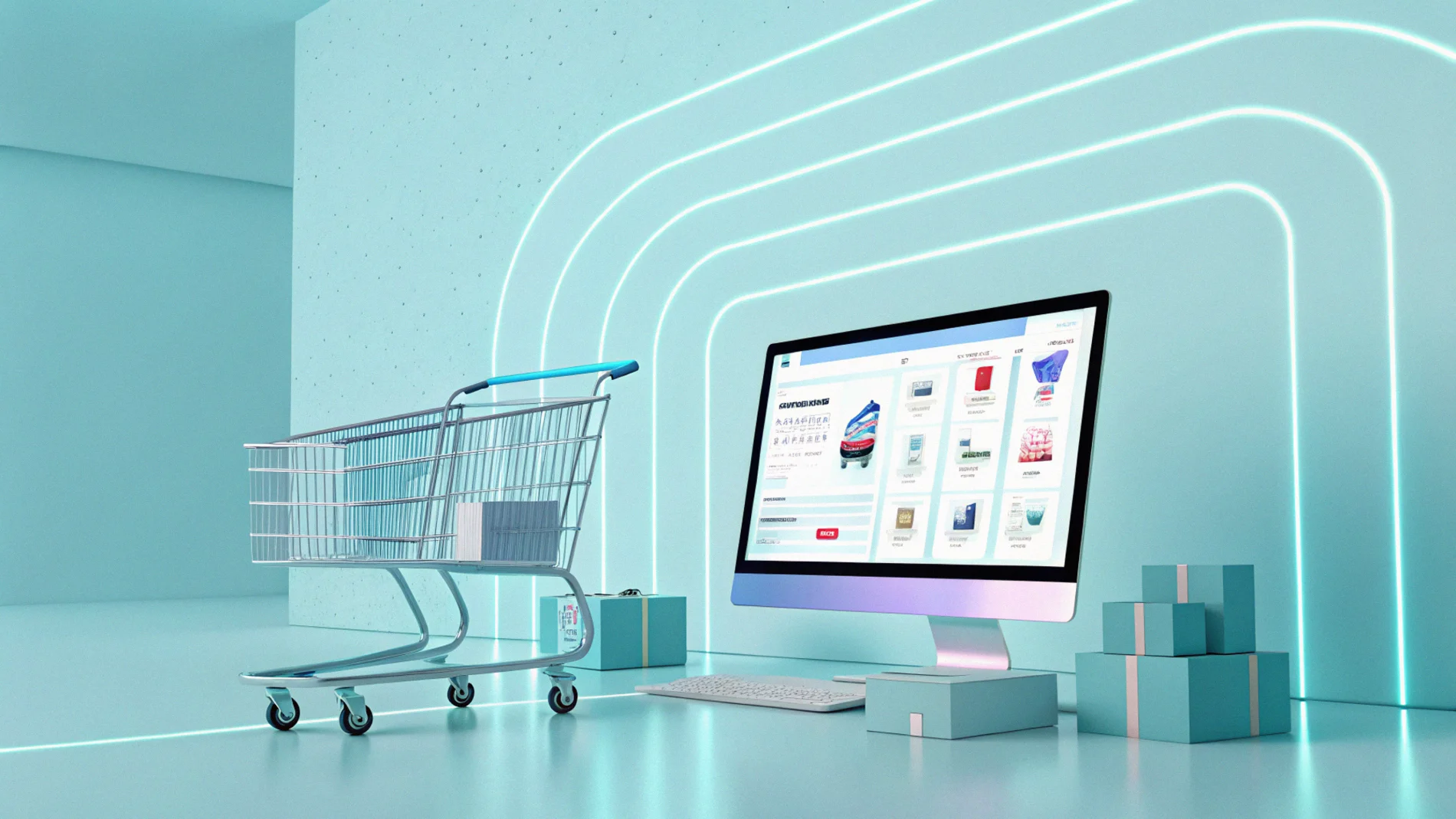Back to all Articles
Karol Andruszków
Karol is a serial entrepreneur who has successfully founded 4 startup companies. With over 11 years of experience in Banking, Financial, IT and eCommerce sector, Karol has provided expert advice to more than 500 companies across 15 countries, including Poland, the USA, the UK, and Portugal.
Marketplace Software Architecture Trends in 2026
Updated:
Wed, Jan 7
Czas czytania: 10 minut

The architecture behind modern marketplaces is changing fast.
In 2025, teams will no longer build platforms as single systems. Instead, they rely on modular services, cloud tools, and ready-made integrations to move faster and scale smarter.
This change shows real needs today:
In this article, we break down the key architecture patterns building the future of marketplaces. We are discussing headless setups, composable stacks, serverless functions and micro-frontends. We also look at how AI and automation are finding a place in both the user experience and the backend systems that power it.
If you're building or scaling a marketplace today, these trends matter. They can help you move faster, reduce long-term costs, and prepare your product for growth.
In 2025, teams will no longer build platforms as single systems. Instead, they rely on modular services, cloud tools, and ready-made integrations to move faster and scale smarter.
This change shows real needs today:
- Releasing new features without breaking what works
- Supporting multiple channels and brands
- Handling traffic spikes without overbuilding infrastructure
- Adding AI or automation without rewriting the whole backend
In this article, we break down the key architecture patterns building the future of marketplaces. We are discussing headless setups, composable stacks, serverless functions and micro-frontends. We also look at how AI and automation are finding a place in both the user experience and the backend systems that power it.
If you're building or scaling a marketplace today, these trends matter. They can help you move faster, reduce long-term costs, and prepare your product for growth.
Key Statistics and How Marketplace Architecture Is Evolving
Before diving into specific architecture patterns, it’s helpful to look at the numbers:
These numbers help explain why the following trends including headless setups, composable commerce, serverless design, and AI integration are not just technical preferences. They reflect the broader direction the industry is heading toward.
Let’s explore what each of these approaches looks like in practice and what they mean for marketplaces launching or scaling in 2025.
- Microservices are becoming the standard. The global market for microservices architecture is projected to reach $21.61 billion by 2030, growing at a CAGR of 18.66% from 2022. By 2026, an estimated 90% of new applications will be built using microservices to boost scalability and flexibility.
- Headless architecture is now mainstream. In 2025, about 64% of enterprises are using headless systems. This represetns a strong move toward separating frontends from backend logic to improve speed, design freedom, and cross-channel support.
- Marketplaces are adopting these trends early. At Ulan Software, we observe this. Around 80% of our clients consider microservices and headless architecture when starting to build their marketplace platforms.
These numbers help explain why the following trends including headless setups, composable commerce, serverless design, and AI integration are not just technical preferences. They reflect the broader direction the industry is heading toward.
Let’s explore what each of these approaches looks like in practice and what they mean for marketplaces launching or scaling in 2025.
Headless Commerce Architecture
A headless setup separates how a marketplace looks from how it works. The user interface (such as a website or app) connects to the backend using APIs. This model helps teams work faster and supports new features with less effort.
Works across many channels
One backend can serve many interfaces. Websites, mobile apps, and even smart TV apps can use the same system. If you want to add a voice assistant, like Alexa, you can. The voice interface becomes another API client, not a new system.
More control over the user interface
Frontend teams are free to design any layout. They don’t need to follow backend templates. They can test, adjust, and update the look without changing how the backend works. This reduces risk and speeds up design changes.
Backend stays focused on logic
The backend sends data and follows business rules. It doesn’t control the layout. This split makes the system easier to manage. Other apps or partners can use your API to show marketplace listings on their own sites.
A growing standard
Today, about 64% of companies use headless systems. At Ulan Software, 8 in 10 clients choose headless from the start.
Common technical choices
Headless marketplaces often use REST or GraphQL for data. Many teams pair them with static site tools, such as Next.js. Pages load fast because they are pre-rendered and served through a CDN. APIs update the page content as needed.
Composable Commerce
Composable commerce is a way of building software using small, focused parts instead of one big system. This is like building a system with LEGO blocks. Each block does one thing well, and you can choose the ones you need.
This approach has become popular because it gives teams more control. You don’t need to commit to one vendor or platform. Instead, you pick the best tools for each part of your marketplace. What is more, you can swap them out later if needed.
What does that look like in a real marketplace?
Say you're building a marketplace from scratch. Instead of using an all-in-one solution, you might choose:
Now imagine you want a CMS to let your content team update pages. You don’t need to build one. You could plug in Contentful or Sanity, which let non-technical users edit content directly through a clean interface.
This way of working helps small teams move faster. And it lets large teams stay flexible as the product grows.
Why does this matter?
Because every marketplace changes over time.
Maybe one tool no longer meets your needs. Maybe you want to scale reviews or switch to a new search engine. With a modular setup, you don’t need to tear down your whole system. You just swap out one part.
This is possible because modern services are designed to work through APIs. They talk to each other without needing to be deeply tied together.
Some teams go further by separating out tasks like search, recommendations, or vendor onboarding into stand-alone services. These are often called Packaged Business Capabilities (PBCs). In other words, small apps that do one job, like managing the cart or handling checkout.
This makes it easier to test new features, scale what works, or change direction without delays.
This approach has become popular because it gives teams more control. You don’t need to commit to one vendor or platform. Instead, you pick the best tools for each part of your marketplace. What is more, you can swap them out later if needed.
What does that look like in a real marketplace?
Say you're building a marketplace from scratch. Instead of using an all-in-one solution, you might choose:
- Auth0 for login and user accounts
- Stripe for payments
- Algolia for search
- SendGrid for emails
- Your own custom code for marketplace features
Now imagine you want a CMS to let your content team update pages. You don’t need to build one. You could plug in Contentful or Sanity, which let non-technical users edit content directly through a clean interface.
This way of working helps small teams move faster. And it lets large teams stay flexible as the product grows.
Why does this matter?
Because every marketplace changes over time.
Maybe one tool no longer meets your needs. Maybe you want to scale reviews or switch to a new search engine. With a modular setup, you don’t need to tear down your whole system. You just swap out one part.
This is possible because modern services are designed to work through APIs. They talk to each other without needing to be deeply tied together.
Some teams go further by separating out tasks like search, recommendations, or vendor onboarding into stand-alone services. These are often called Packaged Business Capabilities (PBCs). In other words, small apps that do one job, like managing the cart or handling checkout.
This makes it easier to test new features, scale what works, or change direction without delays.
Serverless and Edge Computing
Serverless and edge computing are changing how marketplaces are built. These approaches let teams run code without managing servers, which makes things simpler and easier to scale.
What is serverless computing?
Serverless doesn't mean there's no server. It means developers don't need to manage one. Cloud providers like AWS Lambda, Azure Functions, and Cloudflare Workers handle the servers behind the scenes.
When someone makes a request, the cloud runs your code. Then it stops until the next request comes in. You pay only for the time your code runs.
This setup works well for small marketplaces or early-stage projects. A full backend can run on serverless functions with data stored in services like DynamoDB or Firebase. No servers to maintain. No need to guess how much capacity you need. Everything scales on demand.
Not just for small projects
Even in large systems, serverless works well for certain jobs. Say a user uploads a product photo. A serverless function can resize the image or check it with image recognition.
Other common tasks include sending emails, updating search indexes, or logging activity. All of them are handled by functions triggered by events.
This way, the core system stays lean, while extra work runs in the background.
What is edge computing?
Edge functions are small pieces of code that run close to the user. Platforms like Cloudflare or Vercel allow this. Instead of running in one place, the code runs at the edge of the network, usually on a content delivery network (CDN).
This helps pages load faster and lets you do things like:
- Show prices in the right currency
- Run A/B tests
- Cache simple API responses
- Check login tokens before reaching the backend
For marketplaces with users in many countries, edge functions can improve speed and cut load times around the world.
How this changes architecture?
Serverless systems tend to follow an event-driven model. Instead of one system doing everything, each task runs as its own function. One function responds to a web request. Another listens for file uploads. A third reacts to a database change.
This setup makes systems more flexible and easier to scale. Each part grows as needed. The trade-off is complexity. Managing many small parts can make debugging harder. But modern tools are getting better at tracking how these parts work together.
Micro-Frontends and Multi-Tenant Frontends
Large marketplaces often grow beyond what one frontend team can manage. Micro-frontends offer a way to split the work while keeping the user experience smooth.
For example:
This setup is useful in big organizations. Teams work in parallel without touching each other’s code. It also makes updates safer and faster, since each part can be tested and deployed on its own.
Do small teams need micro-frontends?
Not right away. Micro-frontends add complexity. Startups and small platforms often do fine with one frontend team. But as the platform grows, splitting the UI into parts can help scale both the codebase and the team.
When does this approach work well?
Micro-frontends are also useful for marketplaces offered as a service. Say your company builds white-label marketplaces for clients in different industries. Each client might need a unique look and feel. But the core features (like checkout or messaging)stay the same.
With micro-frontends, you can:
This setup is advanced but powerful. Companies like Amazon already use similar ideas. Their teams own and ship different parts of the site, often using different tools and timelines.
What are micro-frontends?
A micro-frontend is a small app that handles one part of the user interface. Each part is built and managed by a different team. These parts are then combined to form the full site.
For example:
- One team builds the product browsing page
- Another builds the seller dashboard
- Each team can use a different framework or release on a different schedule
This setup is useful in big organizations. Teams work in parallel without touching each other’s code. It also makes updates safer and faster, since each part can be tested and deployed on its own.
Do small teams need micro-frontends?
Not right away. Micro-frontends add complexity. Startups and small platforms often do fine with one frontend team. But as the platform grows, splitting the UI into parts can help scale both the codebase and the team.
When does this approach work well?
Micro-frontends are also useful for marketplaces offered as a service. Say your company builds white-label marketplaces for clients in different industries. Each client might need a unique look and feel. But the core features (like checkout or messaging)stay the same.
With micro-frontends, you can:
- Give each client a custom shell
- Reuse shared parts like cart, login, or reviews
- Let teams deploy updates without breaking the rest
This setup is advanced but powerful. Companies like Amazon already use similar ideas. Their teams own and ship different parts of the site, often using different tools and timelines.
AI and Automation in Marketplace Architecture
AI is becoming a core part of online marketplace development. It's changing how architecture is designed. In 2025, Alibaba shared its plan to spend over $52 billion on AI and cloud services.
The company will invest this amount over the next three years. This is more than it spent on these areas in the last ten years. The move shows Alibaba’s strong focus on AI and its growing role in cloud computing.
These tools help reduce manual work, improve user experience, and react faster to changes.
Large companies like eBay run internal platforms for this. Smaller teams often use cloud services like Amazon Personalize or Google Vertex AI, which offer pre-trained models that plug into existing systems.
As of 2025, AI is often added to platforms later, not from day one. But that’s starting to change. Some frameworks may soon offer plug-and-play AI modules — like a ready-made recommendation engine or chatbot.
This makes it easier to test, deploy, and scale while keeping changes safe and repeatable.
Taken together, these trends point in one direction: marketplaces are becoming more modular, decoupled, and cloud-native. Modern platforms are:
This gives teams the freedom to move faster and scale without friction.
That said, there’s a trade-off. A complex setup (like event-driven microservices) is harder to build than a simple monolith. The best approach is to design with these ideas in mind but roll them out in stages. You don’t need everything at once.
Companies that grow fast tend to follow this path. Starting small with the right patterns helps avoid rework later.
Continue reading: The Best Stack to Build a Marketplace Platform - 2025 Update
The company will invest this amount over the next three years. This is more than it spent on these areas in the last ten years. The move shows Alibaba’s strong focus on AI and its growing role in cloud computing.
Where marketplaces use AI today?
Many platforms already rely on machine learning for tasks like:- Search and recommendations: Models suggest products based on user behavior
- Content moderation: AI flags scams or harmful content before a person sees it
- Dynamic pricing: Systems adjust prices or listing order based on supply and demand
These tools help reduce manual work, improve user experience, and react faster to changes.
What does this mean for architecture?
To use AI, a marketplace needs space for it in the stack. This could mean:- Data pipelines to collect and clean user behavior
- ML models served through APIs
- A dedicated service layer for recommendations or pricing
Large companies like eBay run internal platforms for this. Smaller teams often use cloud services like Amazon Personalize or Google Vertex AI, which offer pre-trained models that plug into existing systems.
As of 2025, AI is often added to platforms later, not from day one. But that’s starting to change. Some frameworks may soon offer plug-and-play AI modules — like a ready-made recommendation engine or chatbot.
Automation in operations
On the infrastructure side, CI/CD pipelines are now standard. Even if your platform is hosted or built with managed services, it's common to have:- Continuous delivery for frontend and backend code
- Scripts that manage infrastructure with tools like Terraform or CloudFormation
This makes it easier to test, deploy, and scale while keeping changes safe and repeatable.
Taken together, these trends point in one direction: marketplaces are becoming more modular, decoupled, and cloud-native. Modern platforms are:
- Headless by default
- Built from reusable parts (some custom, some third-party)
- Designed to plug in new services (like AI tools) without needing a full rebuild
This gives teams the freedom to move faster and scale without friction.
That said, there’s a trade-off. A complex setup (like event-driven microservices) is harder to build than a simple monolith. The best approach is to design with these ideas in mind but roll them out in stages. You don’t need everything at once.
Companies that grow fast tend to follow this path. Starting small with the right patterns helps avoid rework later.
Continue reading: The Best Stack to Build a Marketplace Platform - 2025 Update
Conclusion
Marketplace software is changing. In 2025, platforms are built to be flexible, not fixed. The goal is to move fast, support many use cases, and change without starting over.
Each trend we covered (headless, composable, serverless, AI) leads in the same direction. Modern marketplaces are built from smaller parts. Each part handles one task. This makes it easier to grow and adapt.
You don’t need everything at once. But if you plan with these patterns in mind, you avoid big problems later. Teams that grow fast often start small but build with long-term needs in mind.
At Ulan Software, we help clients do that. We design and build marketplaces using modular tools, cloud services, and clear architecture. We focus on what works today and what won’t break tomorrow.
If you’re planning a marketplace or thinking about your software setup, we’re here to help. Let's talk.
Each trend we covered (headless, composable, serverless, AI) leads in the same direction. Modern marketplaces are built from smaller parts. Each part handles one task. This makes it easier to grow and adapt.
You don’t need everything at once. But if you plan with these patterns in mind, you avoid big problems later. Teams that grow fast often start small but build with long-term needs in mind.
At Ulan Software, we help clients do that. We design and build marketplaces using modular tools, cloud services, and clear architecture. We focus on what works today and what won’t break tomorrow.
If you’re planning a marketplace or thinking about your software setup, we’re here to help. Let's talk.
Karol Andruszków
Karol is a serial entrepreneur who has successfully founded 4 startup companies. With over 11 years of experience in Banking, Financial, IT and eCommerce sector, Karol has provided expert advice to more than 500 companies across 15 countries, including Poland, the USA, the UK, and Portugal.
Table of Contents:
Recommended Articles
Tue, Dec 30
The Complete Guide to Pet‑Sitting Marketplace Software in 2026
Complete guide to pet-sitting marketplace software in 2026. Learn key features, architecture, UX, payments, trust, and scaling strategies for CTOs.
Thu, Dec 18
9 Must-Have Features in a Home Care Marketplace Platform
Must-have features for a home care marketplace platform. Learn how to build safe, scalable B2C caregiver platforms.
Tue, Dec 9
Why Building an Elderly Care Services Marketplace Is a Good Business Idea?
Discover why an elderly care services marketplace is a strong business idea, from market growth and high-demand niches to key regulations and pricing models.


